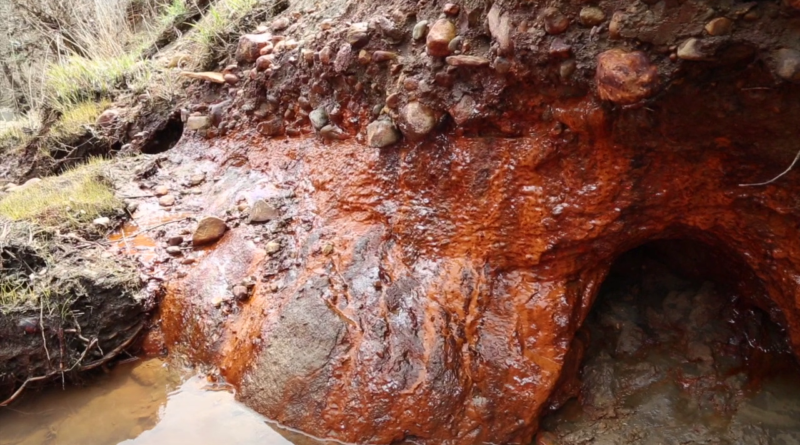Coal Ash Threat to Our Water
Podcast: Play in new window | Download (Duration: 29:57 — 14.5MB)
Subscribe: Apple Podcasts | Spotify | Android | iHeartRadio | Podchaser | Email | TuneIn | RSS | More
(December 6, 2020 – Photo courtesy of Andrew Rehn) The wheels of environmental justice grind slowly. Very slowly, if you ask me. That’s something you learn if your report on these matter for any length of time. Today, we talk about the coal ash threat to our water–whether that means rivers, lakes or groundwater.
We last did a segment on the MIddle Fork of the Vermilion River in April of 2018. At the time, we spoke to Pam and Lan Richarts from Eco-Justice Collaborative (EJC) about a looming danger to the river.
Adding to its mystique, the Middle Fork of the Vermilion is the state’s only officially designated wild and scenic river. Unfortunately, it is now being acknowledged for a more dubious distinction. On April 9, it was named one of America’s Most Endangered Rivers® of 2018 by the American Rivers organization. Incidentally, 2018 marks the 50th anniversary of the Wild and Scenic Rivers Act.
The threat to this great Illinois river can be summed up in two words: coal ash, sometimes known as coal combustion residuals or CCR. The story goes back fifty-five years to the construction of the Vermilion Power Generating Station, a coal-fired power plant, that was built by Illinois Power along the west bank of the Middle Fork of the Vermilion River in 1956. It was purchased by the energy company Dynegy in 2000, which operated the plant until 2011, when it was decommissioned.
However, even though the plant no longer burns coal, the residue of that process remains nearby. As Eco-Justice Collaborative explains,
Over the 55-year period that the facility produced electricity, plant operators needed a place to store coal ash, the waste material produced from burning coal. They determined they could construct storage for this waste near the power plant by using the existing bluffs along the west side of the river as one “wall” for containment, and building berms to the east next to the river channel, to create a second “wall”. While this solution allowed plant operators to take advantage of existing topography, this siting also placed the three storage pits directly in the Middle Fork’s floodplain, which is an integral part of the river’s natural water conveyance system.
These are sometimes known as “legacy ponds.” As Lisa Evans from Earthjustice writes,
Legacy ponds are the walking dead of the coal ash universe — toxic waste sites that live long after coal plants have closed, slipping through regulatory cracks as they continue to poison communities.
In 2018, Prairie Rivers Network filed a federal lawsuit in the U.S. District Court for the Central District of Illinois to force Dynegy to clean up its coal ash, which is slowly but surely leaking into the Vermillion. Dynegy’s plan has been to “cap and run”–basically burying the toxic waste and letting it continue to be a threat to the river. PRN was represented by Earthjustice, which argued that Dynegy is violating the Clean Water Act.
Two years later, Dynegy is now known as Vistra, after having been bought by Vistra Energy Corp. Nonetheless, the battle still rages. Prairie Rivers Network is concerned about three issues:
(1) ongoing pollution of groundwater that runs beneath the pits, and at points running through the pits;
(2) pollution of the Middle Fork through seeps which are hydrologically connected to the buried coal ash; and
(3) the risk of a catastrophic breach, where massive amounts of coal ash could inundate the Middle Fork.
Unfortunately, their suit was dismissed by the U.S. District Court for the Central District of Illinois, which ruled that pollution of surface water through discharges in groundwater isn’t covered by the Clean Water Act. However, they were back in court just a few weeks ago, arguing before the Seventh Circuit US Court of Appeals that the Court should overturn the lower court’s dismissal of the lawsuit.
They are basing their argument on the Supreme Court decision County of Maui v. Hawai’i Wildlife Fund that Earthjustice won this past April. The Supreme Court ruled that, in fact, discharges of pollution through groundwater are covered by the Clean Water Act when they are the functional equivalent of a direct discharge. This oral argument is the first to address how the Supreme Court’s decision should be applied, with important implications not just for Illinois’ treasured waterways but also for rivers and lakes throughout the country.
Meanwhile, the State of Illinois joined North Carolina, Michigan and Virginia by passing a new law regulating coal ash storage and cleanup.
The new Illinois law calls for state standards that are at least as strict as federal standards, and it requires a public process including the opportunity for public meetings.
The new state statute orders the Illinois Environmental Protection Agency to draft specific coal ash rules by March 2020, and, after public input, the Illinois Pollution Control Board must finalize the rules within a year.
Were those rules drafted? How does that law affect the EPA suit? I don’t know. That’s why we welcome back Andrew Rehn, who is a Water Resources Engineer with Prairie Rivers Network.

